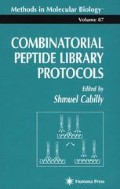Abstract
The open structure of the biocompatible polyethylene glycol polyamide copolymer (PEGA resin) is presented in Fig. 1 , exemplified by the application of the commercially available bis-2-aminopropyl-PEG1900. With the use of this PEG1900, permeability with proteins up to 50 kDa has been achieved, as demonstrated by gel permeation chromatography (1). A resin-bound fluoroescencequenched peptide substrate showed 80% cleavage with subtihsin Carlsberg (MW 27 kDa) in 1 h and the cleavage went to completion in ∼2 h. The resin could also be used for glycopeptide assembly using bovine β-(1→4)-galactosyl transferase (MW 43/49 kDa) to transfer galactose to the 4-position of GlcNAc (2) In this example, the diffusion and reorientation of the enzyme inside the polymer network was a rate-limiting factor for the reaction, which could, however, be brought to completion in 72 h This indicates that the reaction was performed at the practical limit of protein size for preparative enzyme reactions in this resin. PEGA resins perform excellently in solid-phase assays of biomolecular reactions. Furthermore, they are transparent and no light is absorbed above 250 nm, so they can be used with a variety of different chromophores and fluorescent probes for detection of biomolecular reactions.

Preparation of PEGA resin containing PEG1900 by the partial acryloylation procedure.
Access this chapter
Tax calculation will be finalised at checkout
Purchases are for personal use only
References
Auzanneau F I., Meldal M., and Bock K (1995) Synthesis, characterization and biocompatibihty of PEGA resins. J. Pept. Sci. 1, 31–44
Meldal M., Auzanneau F-I., Hindsgaul O., and Palcic M M (1994) A PEGA resin for use in solid phase chemical/enzymatic synthesis of glycopeptides J Chem Soc Chem Commun. 1849,1850
Renil M. and Meldal M (1996) The influence of PEG-crosshnkers on permeable PEGA-resins for large biomolecules J.Pept Sci., to be submitted
Arshady R (1991) Beaded polymer supports and gels J. Chromatogr 586, 181–197
Author information
Authors and Affiliations
Editor information
Editors and Affiliations
Rights and permissions
Copyright information
© 1998 Humana Press Inc., Totowa, NJ
About this protocol
Cite this protocol
Meldal, M. (1998). Preparation of Biocompatible Resins for Library Syntheses. In: Cabilly, S. (eds) Combinatorial Peptide Library Protocols. Methods in Molecular Biology™, vol 87. Humana Press. https://doi.org/10.1385/0-89603-392-9:59
Download citation
DOI: https://doi.org/10.1385/0-89603-392-9:59
Publisher Name: Humana Press
Print ISBN: 978-0-89603-392-4
Online ISBN: 978-1-59259-571-6
eBook Packages: Springer Protocols

